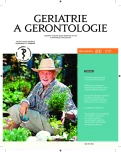Assessing the dependency levels for the purposes of care benefit claims on the basis of functional assessment
Authors:
doc. MUDr. Libuše Čeledová, Ph.D. 1; MUDr. Rostislav Čevela, Ph.D.; Mba 1; PhDr. Jitka Bienertová 2
Authors‘ workplace:
Ústav sociálního lékařství LF UK Plzeň
1; Zdravotně sociální fakulta JU České Budějovice
2
Published in:
Geriatrie a Gerontologie 2014, 3, č. 2: 82-87
Category:
Original Article/Study
Overview
The article informs the reader about the medical criteria for assessing dependency levels for the purposes of benefit claims according to the social services act. The medical criteria were set up in accordance with assessment of the activities of daily living and the principles of the International Classification of Functioning, Disability and Health. Based on the two-year experience with the new assessment criteria of the function status of the elderly patients, the model proved efficient and has been an asset to all the elderly patients. In conclusion, the authors emphasize the need to apply a multidisciplinary approach to assessment and to expand the evaluation teams, currently composed of a medical assessor, a general practitioner and a social worker, by adding an ergotherapy practitioner. Professional ergotherapeutic evaluation must be simultaneously accompanied by ergotherapeutic interventions in order to maintain the highest degree of self-sufficiency for the elderly patients.
Keywords:
dependency levels – ergotherapy – functional assessment
Sources
1. Zvoníková A, Wernerová J. Využití Mezinárodní klasifikace funkčních poruch, disability a zdraví – ADL a IADL v posuzování stupně závislosti. Geri a Gero 2013; 2(3): 138–142.
2. Čeledová L, Čevela R, Ornerová A. První zkušenosti s personalizovaným posuzováním stupně závislosti pro účely příspěvku na péči. Čas Lék Čes 2013; 152(6): 274–277.
3. Čeledová L, Čevela R, Doležal T, Klimeš J. Health Technology Assessment (HTA) v principech a zásadách posuzování stupně závislosti. Prakt Lék 2012; 92(5): 267–269.
4. Čeledová L, Čevela R. Úloha posudkového lékaře a sociálního pracovníka v řízení o příspěvku na péči. Kontakt 2011; 13(1): 48–53.
5. Interní materiály ČSSZ, 2013.
6. Jelínková J, Krivošíková M, Šajtarová l. Ergoterapie. Praha: Portál 2009. s. 272.
7. Kalvach Z. Geriatrie. In: Kolář P et al. Rehabilitace v klinické praxi. Praha: Galén 2009. s. 601–609.
8. Schőnová V. Kolář P. Ergoterapie. In: Kolář P. et al. Rehabilitace v klinické praxi. Praha: Galén 2009. s. 297–298.
9. Švestková O a kol. Metodika hodnocení funkčních činností a pracovního potenciálu, PENTACOM. vydané v rámci projektu Iniciativy Společenství EQUAL „Rehabilitace – Aktivace – Práce“, 2008.
10. Švestková O a kol. Metodiky hodnocení psychosenzomotorického potenciálu člověka. PENTACOM. vydané v rámci projektu Iniciativy Společenství EQUAL „Rehabilitace – Aktivace – Práce“, 2008.
11. Jedlinská M. Funkční hodnocení seniorů, teorie a praxe. Geri a Gero 2013; 2(3): 134–137.
12. Macháčová K. Problematika hodnocení tělesné způsobilosti u seniorské populace. Geri a Gero 2013; 2(3): 131–133.
13. Matějovský J, Matějovská Kubešová H, Meluzínová H. Zhodnocení funkčního stavu seniorské populace žijící ve vlastním prostředí a vyhodnocení vybraných rizikových faktorů snížení soběstačnosti. Geri a Gero 2012; 1(2): 65–70.
14. Bruthansová D, Červenková A, Jeřábková V. Nová klasifikace nemoci a zdraví. Čes Ger Rev 2009; 7(2): 90–96.
15. Švestková O, Pfeieffer J. Funkční hodnocení (diagnostika) v rehabilitaci. Prakt Lék 2009; 89(5): 268–271.
16. Kalvach Z, Drbal C, Zavázalová H a kol. Geriatrický pohled na zdraví a nemocnost ve stáří – změna paradigmatu? Čas Lék Čes 2006; 145 : 909–915.
17. Weber P, Ambrošová P, Weberová D, Bieláková K. Geriatrické syndromy a syndrom frailty – zlatý grál geriatrické medicíny. Vnitř Lék 2011; 57(11): E 2010–18.
18. Topinková E, Berková M, Mádlová P, Běláček J.. Krátká baterie pro testování fyzické zdatnosti seniorů a její využití pro diagnózu geriatrické křehkosti v klinické praxi. Geri a Gero 2013; 2(1): 43–49.
19. Kalvach Z, Zadák Z, Jirák R a kol. Geriatrické syndromy a geriatrický pacient. Praha: Grada Publishing 2008. s. 336.
20. Starostová O, Vepřková P, Holmerová I, Wija P. Aktivní stárnutí v obcích ČR. Geri a Gero 2013; 2(3): 128–130.
21. Peškeová M. Sociální práce na geriatrickém pracovišti. Geri a Gero 2013; 2(3): 176–177.
Labels
Geriatrics General practitioner for adults Orthopaedic prostheticsArticle was published in
Geriatrics and Gerontology

2014 Issue 2
- Metamizole at a Glance and in Practice – Effective Non-Opioid Analgesic for All Ages
- Memantine in Dementia Therapy – Current Findings and Possible Future Applications
- Advances in the Treatment of Myasthenia Gravis on the Horizon
- Hope Awakens with Early Diagnosis of Parkinson's Disease Based on Skin Odor
Most read in this issue
- Assessing the dependency levels for the purposes of care benefit claims on the basis of functional assessment
- Type 2 diabetes mellitus in old age
- A pharmacotherapy of nursing home residents.
- Anabolic resistance
